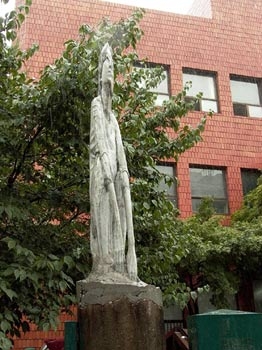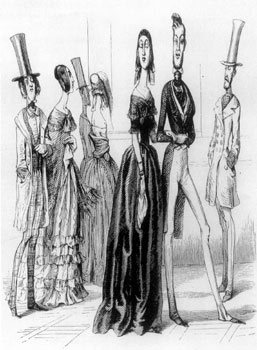|
Disturbance Towards Serenity
The Distinct Characteristics of Lee Hwan-kwon’s Media
Heui-yeong Yi, Art Critic
Adjunct Professor, University of Incheon
Recently, the Korean art arena is sizzling. The price of celebrated artists’ work rises to record high, and even young artists’ works are sold at a higher price than before.
|
.jpg)
|
|
Bald Man, 2005, FRP, 175x20x20 | Newspapers fuel this tendency by presenting somewhat exaggerated statistical data. Yi, Hwan-kwon is a young artist who should be a man of great wealth, as his reputation is known throughout the Korean art scene, but he grapples with his time-consuming, labor-intensive work, without departure from the habits of his poverty.
Yi’s success is due largely to the fact his work is easy to access, while offering bewildering, unfamiliar experience. It is a representation of common objects and simultaneously a distortion of their form: this is why their viewers might feel giddy.1) This paradox is a feature of his work from early particular versions in 2000 to recent series as A Windy Day, 2007. This paradox is the constant flowing throughout his works, and an example of why I believe artists of his generation(born in the 1970s) should free themselves from response to ideology and define their art intuitively.
|
.jpg)
|
|
fig. 6 A Windy Day Version, 2007, FRP
Woman 234x64x108; Postbox 178x85x68 |
Motivation
Yi, Hwan-kwon trained as a professional artist in the early 1990s, when art students were exposed to an avalanche of information, thus losing their own ideological direction.
|
1) Lee Tae-ho, “Speaking to a Real World in the World of Images”, A Windy Day, Yi, Hwan-kwon’s sculpture exhibition catalog, POSCO Art Museum, 2007
2) Yi, Hwan-kwon, “Artist’s Note”
3) Yi, Hwan-kwon, “Work Description” | | It was a period marked by pop culture’s liveliness, the rapid development of the internet, use by artists of visual technology, and the emergence of Eco Art.
Yi, Hwan Kwon says he distorts form in reference to the elongated world appearing on television when wide-screen film is broadcast.2) This shows his response to technology and attempt to deal with the contradictions of conventional sculpture, by pursuing vitality confined to stillness.3) It also implies self-confidence in reaction to given information. Figures in his work are engrossed in their own movement, turned attention away from viewers. They seem to plunge into their own world.
|

|
fig. 1. Min-hyung, 2000, FRP & cement
130x18x27 | This is because Yi, Hwan Kwon represents figures resulting from ecological order, rather than from self-centered humanism. Three motives Yi presents in his work are an inquisitive mindset toward technology; self-confidence in pursuit of liveliness; and an ecological attitude toward representation of objects.
Disturbance
Yi, Hwan Kwon works without the pedestals, often considered essential to presenting sculpture. His work is placed in environments that expose their essence. So there is no clear frame to distinguish between the real space and the artistic space. Like a specific object in a picture puzzle, each sculpture is incorporated into its environment without revealing their essence. An example is Min-hyung(fig. 1), installed on one of the annex pillars of the Seoul National University Hospital. The pillar worked as pedestal of the sculpture, the form of which contracted vertically, and appeared mingled with nearby objects, without revealing its strange presence, too obviously. Placed in a daily environment it seemed familiar to spectator’s eye.
|
.jpg)
|
fig. 2. The Copy Shop's Son and Daughter
2002~2004, Bronze, 300x45x45;
200x45x110 |
Yi’s works are captured all of a sudden. They have no exceptional gestures that disturb spectator’s gaze: each figure can be seen in daily life. The two figures of The Copy Shop’s Son and Daughter(fig. 2) stand still for example, and have an upward glance - they do not appeal to viewer’s eyes. They look so familiar that the spectator may have easy relations with them. This familiarity comes from Yi’s eliminating conventional frames, assimilating each sculpture into their surrounding through contraction of form, and presentation of objects indifferent to experienced memory.
The spectator can be astonished, feel giddy when they discover his work in a specific environment. Though they may already have experienced vertically elongated forms in Edvard Munch’s and Alberto Giacometii’s work, they get perplexed by Yi’s work, because his familiar figures offer the sudden appearance of deformed shape.4) In his work, spectator’s memories, entirely reliant on images, paradoxically collide with the substantial scene of reality, which occurs all of a sudden.
|
.jpg)
|
fig. 3. Gustave Caillebotte, Little People, Woodcu
3x5 2/3in., form Un Autre Monde |
The collision arouses difference between the time it takes to decipher an object and the time it takes to decipher their surroundings. As a spectator’s point of view moves, the sculptures go through rapid changes, because they contract in comparison to their surroundings. This plight brings about a certain speed of lively sculpture that is the objective of Yi’s art. By his work, spectator is involved aggressively in a collision of speeds, and is asked to incorporate them both. Yi’s work poses epistemological questions concerning difference between experiences past and present.
| 4) Yu Jin-sang, “Yi, Hwan-kwon: The Moment of Contracting or Extending”, Bus Stop, Yi, Hwan-kwon Sculpture Exhibition, Sejong Center Art Museum. 2005
Yu Jin-sang, “A Space Between Others, Yi, Hwan-kwon Sculpture Exhibition”, Invitied show by EBS Space, EBS Space Exhibit Room, 2006 | |
Images
After taking pictures of the figures we often meet in our daily life, Yi Hwan-kwon digitally modifies them and reproduces them in three-dimensional form.5) They compare with work by Gustave Caillebotte from 160 years ago(fig. 3, 4). Through the writing collection of his illustrations, Another World(Un Autre Monde), 1884, Caillebotte brought surrealistic illusion to his readers.6) He presented a world rarely experienced in daily life in a realistic manner. Another example of this is Gegoire Huret, who strived in 1670 to prove order through drastic difference between foreground and background(fig. 5).7)
|

|
fig. 4. Gustave Caillebotte, Grand People
Woodcut, 5 3/4x4 1/3in. form Un Autre
Monde |
Caillebotte’s realistic representation and Huret’s order are fundamental principles in Yi’s modification of form, echoing Renaissance masters who struggled to present a law of three-dimensionality on a two-dimensional medium. Based on classical principles, they applied this law to form and color in a uniform, elaborate manner, developing the presentation of pictorial space.
|
5) “2007 Culture, New Year’s Dream: Sculptor Yi, Hwan-kwon”, Yunhap News, January 2007
6) Kirk Varnedoe, A Fine Disregard What Makes Modern Art Modern, Thames and Hudson, 1990, pp.234-238
7) Carl Godstein, “Towards a Definition of Academic Art”, The Art Bulletin, Vo. LVII, No.1, pp.103-108 | | Medieval painters held the belief images they produced resembled things in reality and even become reality itself: Renaissance painters broke from the middle ages by synthesizing experience acquired through natural and precise scientific observation. They were trailblazers who led the medium of painting into three-dimensional space, paving the way for sculptors and artists like Yi, Hwan-kwon.
.jpg) |
|
fig. 5 Gégoire Huret, Various
Anamorphic Designs Showing the
Distortion Produced-by Distance and
Curved Surface, 1670 |
Unlike painting, dependent on illusion, three-dimensional space is a fundamental condition for the interpretation of sculpture. As Yi commented, sculpture has mass, irrespective of illusory images. Yi, Hwan-kwon’s sculpture strives to resemble painting, refusing the major tendencies in sculpture’s evolution. Although his sculpture takes up physical space and time, it relies heavily on pictorial space and time for its interpretation, which brings about the plight and dizziness. Yi exploits visual technology, inspired by the masters of the past, to replace their established laws in the present.
Serenity
Yi, Hwan-kwon synthesized all his works under the two categories: one is Bus Stop series exhibited at the 2005 one person exhibition and another series, A Windy Day at the 2007 one person exhibition. Yi presented also the same version yet different edition of Bus Stop at the show Between Others which took place between the two exhibitions. While his first Bus Stop was mostly made in his training period, recent serial work of the same title shows deformation caused not only by up-and-down, right-and-left
|
.jpg)
|
fig. 6 A Windy Day Version, 2007, FRP
Woman 234x64x108; Postbox 178x85x68 | contractions, but by forward-and-backward movement. Yi’s sculpture is not merely placed in viewer’s reality but infiltrates more aggressively into it.
What stands out in his recent work is a representation of the invisible such as wind(A Windy Day, fig. 6) and tedium(I Don’t Want to Study Today, fig. 7). The artist uses the protrusion and recession of deformed figures and objects to express these invisible, intangible elements. He exploits the laws developed by the artists of the past to represent visual solidity and individuality for a figurative expression more than visual features of art. These laws make possible narrative expressions such as ‘undulating movement’ or ‘tedious mind’. Yi’s sculpture is distinguished from that of the masters of the past in that such laws are embodied in realistic surroundings. In other words, he works in sculpture creating a critical pictorial space.
If contraction and deformation collide an environment more strongly, the literary figurative seems vain and empty. This is why Yi’s sculpture is not fully suggestive, namely suggestion is not enough to interpret his work and inspire others.
|
.jpg)
|
fig. 7 I Don't Want to Study Today, 2007,
100x72x110 | In more recent works, props are rarely used or otherwise, enjoy the same status as figures. This is due largely to his form emphasizing its own individuality. Going beyond friction between environments and objects, his sculpture brings about more clashes between sight and figurative, the visible and invisible. As he mentioned, these are the clashes of rapid ‘spiritual speeds’ and ‘viewer’s observation’. While the subject of ‘spiritual speeds’ tries to move forward, the subject of ‘observation’ wants to stay. We might have an intense feeling of serenity at the end of these clashes.8)
…
Yi, Hwan-kwon tries to realize the transformation of images in real space through his sculpture, rectifying an established belief that such deformation is possible only in a plane surface. By doing it, Yi’s medium makes spectator pose epistemological questions concerning their existence. This begins with his intention to recover vitality in sculpture by stimulating his curiosity toward technology, overcoming a contradiction of conventional sculpture.
Going against the stream of contemporary art, Yi presents concrete, substantial images not in a simply imaginary, abstract state but in a real situation. His practice bears a similarity to the method of past masters who were dependent on mathematical proportion, but its result appears quite different. What he attained is the creation of critical pictorial space. By doing it, as an individual, he responds to both the past and his present times.
Translated by Lee, Jeong-young |